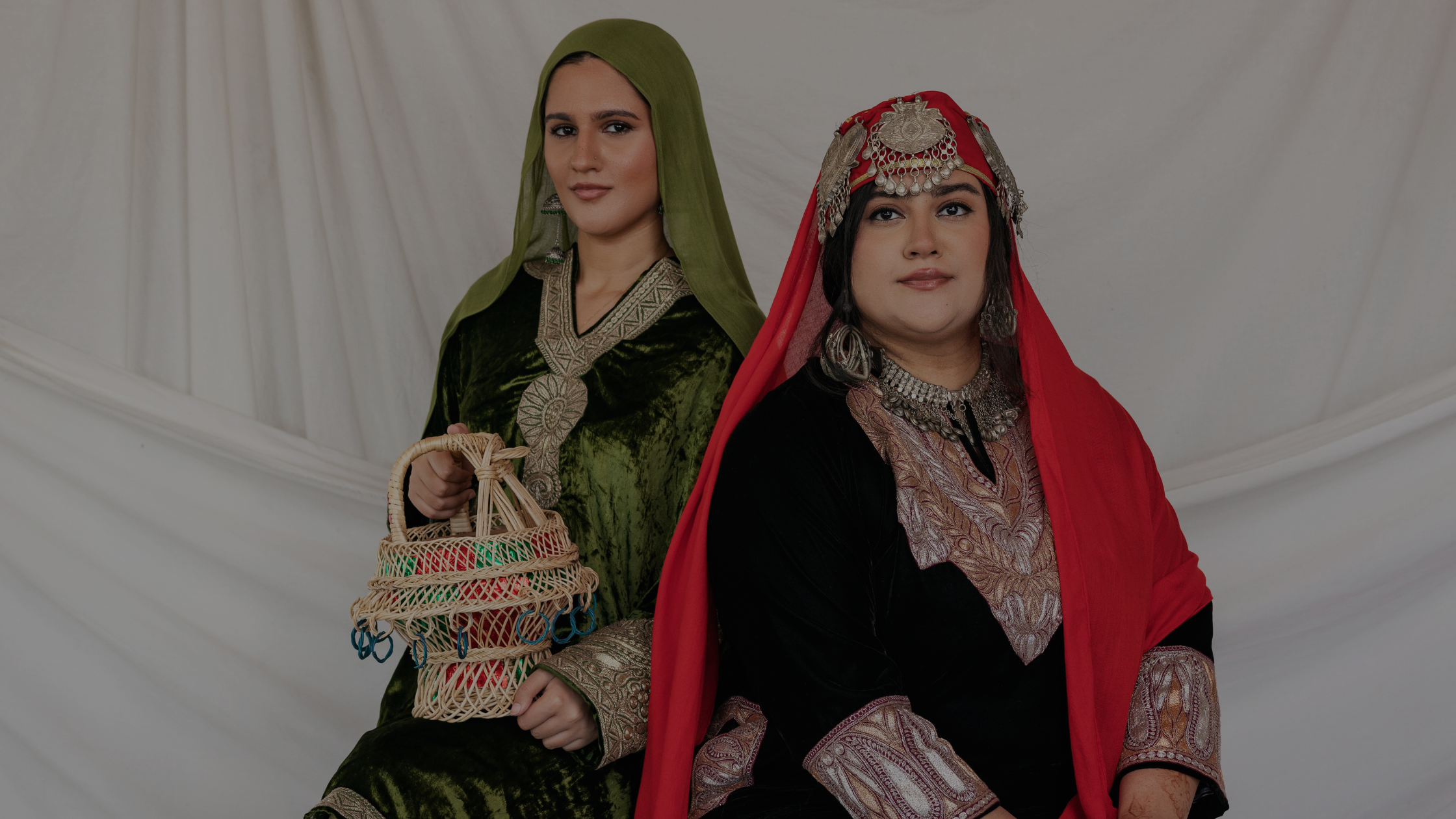
We come from a land with the most breathtaking landscapes, facing one of the most brutal military occupations in the world. As Kashmiri activists and scholars who have dedicated years to researching, learning and educating others about the history of Kashmir and our people’s struggle for freedom in the face of occupation, we are writing this blog to briefly introduce you to a piece of our culture and urge those who wear our symbols to do so with consciousness and care.
Today, as the world rediscovers Kashmiri fashion, from intricately designed pashmina shawls and scarves to the famous buta (paisley) motif, we find ourselves at a critical juncture: will this resurgence of Kashmiri fashion across the world lead to recognition of our people’s struggles and liberation from occupation? Or will this become yet another chapter of appropriation, commodification, and erasure?
From Kuffiyehs to Pashminas: Fashion as Resistance
Just as the kuffiyeh has become a global symbol of Palestinian resistance and solidarity against settler colonialism, genocide and ethnic cleansing, we believe pashmina shawls and Kashmiri motifs like the buta (the original name for the paisley) hold a similar potential. When worn with intention, support for Kashmiris living under occupation and an acknowledgement of these cultural symbols’ roots in Kashmir, they can become statements of solidarity, tools of remembrance and symbols of resilience against India’s military occupation, ethnic cleansing and cultural erasure of Kashmir and its people.
Unfortunately, this kind of solidarity, remembrance, and care is rarely given to the Pashmina and motifs like the buta. Large fast fashion companies typically create cheap copies of Pashmina shawls, endangering the original shawl-weaving industry in Kashmir, or replicate designs like the buta without acknowledging its history. In the process, the stories and struggles behind Kashmiri cultural artifacts, carefully made by artisans resisting not only economic exploitation but decades of cultural annihilation and occupation, are erased.
A History of Exploitation
The exploitation of Kashmiri cultural artifacts like our shawls is not recent or new. During the 19th century, under British imperial rule, Kashmiri shawls became coveted, luxury items enjoyed by European elites from Empress Josephine of France, Queen Victoria, to countless other aristocrats. Kashmiri shawl weavers including men, women and even children took days weaving each shawl. They worked in cramped spaces under horrible conditions and had meager wages.
On April 29th, 1865, Kashmiri shawl weavers hit the streets of Zaldagar, Srinagar in protest against the high taxes placed upon them by the Dogra rulers at the time. The Dogra Army attacked the unarmed protesters, drowning at least 28 and leaving scores injured. They were among the first martyrs of a labor movement in modern history, and yet, they remain unrecognized by much of the world.
For our colonizers, the ‘exotic’ aesthetic and visual appeal of our culture and fashion held immense value, and they vehemently exploited our people and our culture to meet the needs of a frenzied populace who earned status, recognition and awe by adorning our cultural clothing. This happens across cultures and across resources that are extracted to please the capitalistic desires of consumers, no matter the human costs associated with it. Whether it's the physical pain endured by labourers or the psychological pain of slowly losing your cultural symbols and clothing to people who decontextualize their meaning, significance, and reduce them to mere commodities to show off.
Today, the Kashmiri shawl weaving industry faces continued challenges due to cheap, fast-fashion knock-offs, synthetic blends and uses of our motifs without credit or acknowledgment towards our homeland, our people and our suffering under occupation. This exploitation, especially while Kashmiris face ethnic cleansing and occupation, are suffocating the original art forms that Kashmir has been known for, for centuries. They either undermine the livelihoods of indigenous artisans and/or accelerate the erasure of Kashmiri culture and identity, when the spread of our culture and its fashion should be a means of resisting erasure and preserving our identity instead.
 Cultural Symbols Are Not Just Aesthetic
Cultural Symbols Are Not Just Aesthetic
Over the past few years, we’ve quietly observed the resurgence of Kashmiri fashion in mainstream social media content. Muslim women in particular have embraced Pashmina-style scarves as part of modest fashion. It is moving to see a symbol from our culture carried by so many Muslim sisters across continents. But we urge them all to embrace this part of our culture with an awareness that this is not just a fabric or a fashionable trend to partake in. Pashmina shawls have been a part of Kashmiri culture, identity, and our people’s resistance not just for decades, but centuries. Pashmina shawls originally come from a place under siege, whose people face extrajudicial killings, sexual violence, arbitrary arrests, silencing, and much more.
It is easy to follow a trend and buy a pretty scarf. It is harder, but far more meaningful and impactful, to ask: What story does this piece carry? Is it inspired by Kashmiri heritage in a way that honors its origins? Is it a Kashmiri brand/artisan or is the company thoughtfully creating the piece in solidarity with Kashmiris? Are they acknowledging the Kashmiri occupation and expressing solidarity with the Kashmiri people? Am I wearing this scarf as a form of solidarity with Kashmiris living under occupation or simply as an accessory? When done right, Kashmiri fashion’s expansion internationally can be a powerful act of remembrance and solidarity. What matters is the intention behind how these cultural symbols are represented, how they support Kashmiri communities and their struggles against occupation, and the care with which they are shared.
We ask our fellow Muslims and all those who wish to stand up against injustices to not let pashmina scarves, shawls or motifs from Kashmiri culture be another neutral fashion statement. If you chose to wear this piece of our culture, let it be an intentional, political choice. One in which you carefully choose where you purchase your piece of Kashmiri culture from, so that you can say, “I stand with Kashmir. I acknowledge the injustices they’ve endured and wear this to ensure others do too.”
Ethical Consumption and Solidarity
We don’t want to gatekeep Kashmiri fashion. For centuries, Kashmiri fashion has had a profound cultural impact across the world, and will continue to do so. But we urge you to let your engagement with and consumption of our culture be intentional, and rooted in solidarity, ethics and justice.
Support the revival of Kashmiri fashion in a way that honours our people’s struggle. This can be done in several ways, whether you buy directly from Kashmiri artisans or choose to purchase from brands that are inspired by and acknowledge the roots of these designs and are committed to standing in solidarity with our people. Again, when you choose to wear a piece from or inspired by Kashmiri fashion, let it be with intention. Share the history of the Kashmiri shawl weaving industry. Learn more about the ongoing occupation, disappearances, mass graves and censorship of Kashmir and Kashmiris, and the resistance of our people that has continued for centuries. Feel free to wear our art, but do not forget the people behind it. Appreciate our culture, but only if you will stand with us in our struggle for freedom against occupation. Help us ensure that this moment of Kashmiri fashion’s resurgence is a tool for our liberation, not erasure.
#FreeKashmir



Leave a comment